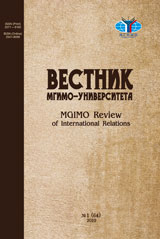
Journal’s description
The MGIMO Review of International Relations is a peer-reviewed journal on international relations. The Journal’s main goals and objectives are:
- To publish original research on international relations: contemporary international political science, history of international relations, regional studies, global and regional governance, as well as world economy and international political economy. Particular attention is dedicated to the analysis of the Russia’s role in the international system and the system’s impact on Russia.
- To further develop the Russian School of International Relations. The journal seeks to consolidate and promote this School worldwide. The School has largely been formed around the Moscow State Institute of International Relations (MGIMO-University), its professors and graduates. MGIMO-University is home for the Russian International Studies Association (RISA, Russian branch of International Studies Association, ISA). Academician Anatoly V. Torkunov, the Rector of the University and the chief editor of our journal, is the President of RISA. The Russian School of international relations combines the following areas of research: world politics, history of international relations, applied analysis of international problems, regional studies, as well as global governance. At the normative level the school supports the democratic organization of international relations. It emphasizes the value of cultural and civilizational diversity, as well as pluralism in ways of studying, understanding and managing international relations. Methodologically it is based primarily on qualitative research methods.
- To promote international scientific discussion and communication among scholars working within the framework of the Russian School of International Relations. These scholars work in major international relations research centers both in Russia and abroad (USA, Canada, Great Britain, Germany, France, China, etc.) and publish their academic papers both in Russian and in English.
Subject Area and Subject Category
The MGIMO Review of International Relations publishes articles in the subject category «Political Science and International Relations» within subject area «social sciences». Following the development of the Russian school of International Relations the journal «MGIMO Review of International Relations» focuses primarily on the following themes within the subject category «Political Science and International Relations»:
- international politics,
- history of international relations,
- theory of international relations,
- international political economy,
- regional studies,
- international security,
- global governance.
The emphasis is given to international politics, history of international relations and international political economy.
International law is not included in the journal’s scope. We also do not welcome articles on comparative politics. We publish them only if the problems raised reflect regional or global trends.
Geographical Scope
The MGIMO Review of International Relations has a wide geography of authors, editorial board members and reviewers. We receive articles and citations from Armenia, Australia, Austria, Canada, Finland, Germany, Great Britain, Kazakhstan, Mexico, Poland, Serbia, Slovakia, South Korea, Switzerland, Ukraine, USA. Recently the journal has become popular among scholars from Iran and Turkey.
The editorial board consists of outstanding specialists in international relations from all over the world. More than one third of the editorial board are international scholars and they either belong to the Russian school of International Relations or study Russia in the context of international relations (USA, UK, France, Serbia, Bulgaria).
The rest of the members are scientists who represent the Russian school of International Relations in the leading think-tanks from all over Russia (Moscow, St. Petersburg, Nizhny Novgorod).


































